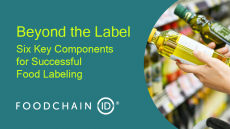FDA expands use of 'lean' label for convenience foods
'lean' nutritional claim, after the US Food and Drug Administration
expanded the use of the term.
Under the final rule published last week, manufacturers of goods such as burritos, pizza rolls, egg rolls, and sandwiches will be able to use the well-recognized claim to appeal to health-conscious consumers.
The move is the result of a petition filed by prepared foods company Nestlé in 2004. The firm had proposed that the term be approved for use on "mixed dished not measurable with a cup".
"In Nestlé's experience, and as evident in the marketplace, 'lean' has provided consumers with a valuable and accurate way to identify from the food label products that are formulated in a fashion that assists individuals in constructing overall diets consistent with consensus dietary guidance," said the firm.
The final rule allows for the nutrient content claim to be used on products that have less than 8 g total fat, 3.5 g or less saturated fat, and less than 80 mg cholesterol per reference amount customarily consumed (RACC) (140 g). These levels are marginally higher than those proposed by Nestlé's petition.
Prior to this FDA rule, the nutrient content claim 'lean' applied only to seafood and game meat products and meal and main dish products regulated by FDA that meet the criteria set forth by the agency for these categories. USDA also already allowed 'lean' claims for meat and poultry products that fall under its regulation.
As a result, the term already has broad appeal with consumers, said Nestlé.
"At no time have the benefits of foods with controlled levels of fat, saturated fat, and cholesterol been more important, particularly when combined with the benefit of portion control. Nutritional alternatives to traditional 'on the go' fare are particularly important in light of changes in the way consumers prepare and consume foods," said the firm in its petition.
According to the company, the expanded uses of the term is a useful mid-point between hand-held healthful foods and traditional alternatives.
FDA said it acknowledges that meals-on-the-go have made their way into consumers' diets as a convenient meal option.
"With controlled nutrient and portion size, these foods serve a useful purpose in assisting consumers in selecting a diet that is consistent with recommended US Dietary Guidelines," said the agency.

















